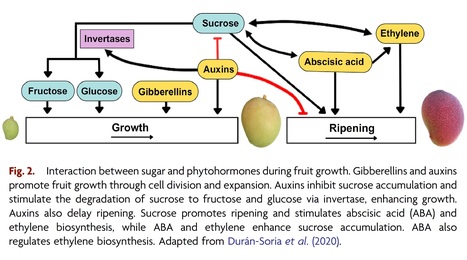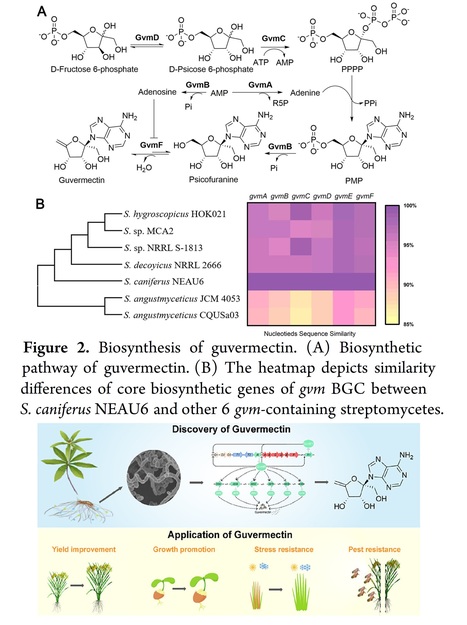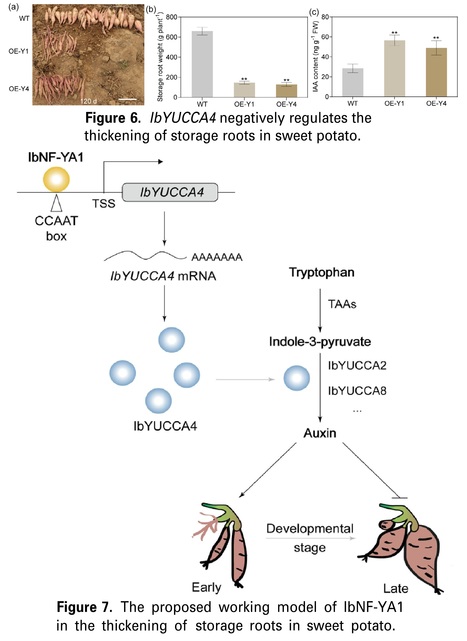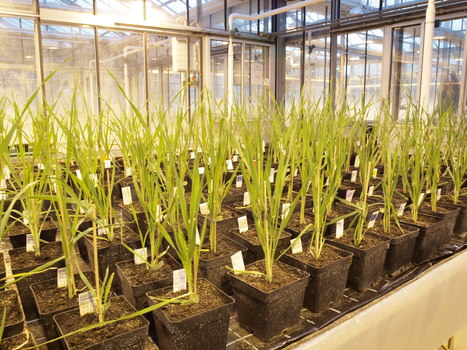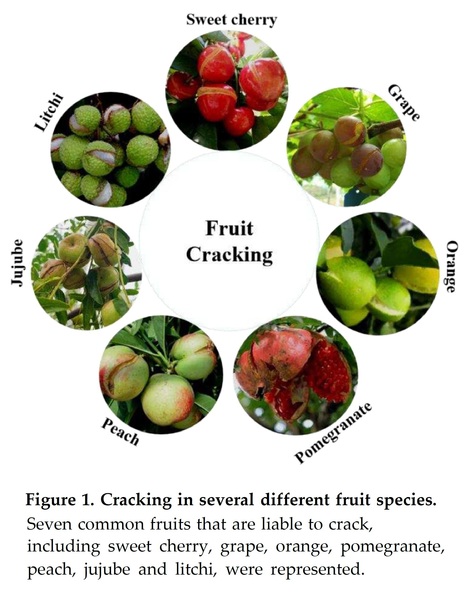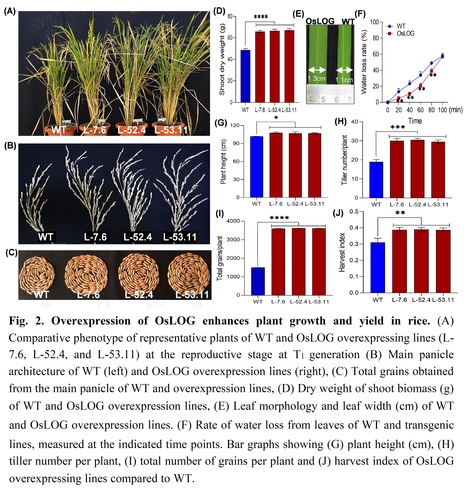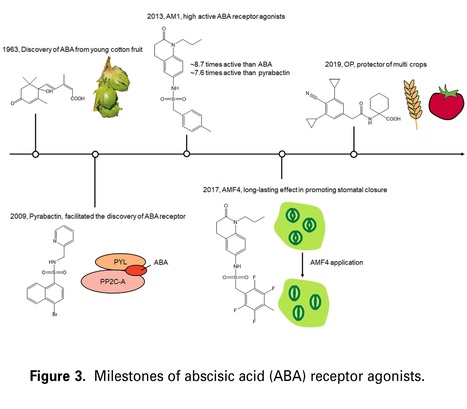 Your new post is loading...
 Your new post is loading...
Authors: Xiaolin Liu, Shusong Zheng, Shuiquan Tian, Yaoqi Si, Shengwei Ma, Hong-Qing Ling and Jianqing Niu.
Theoretical and Applied Genetics (2024)
Key message: Discovery of Rht27, a dwarf gene in wheat, showed potential in enhancing grain yield by reducing plant height.
Abstract: "Plant height plays a crucial role in crop architecture and grain yield, and semi-dwarf Reduced Height (Rht) alleles contribute to lodging resistance and were important in “Green Revolution.” However, the use of these alleles is associated with some negative side effects in some environments, such as reduced coleoptile length, low nitrogen use efficiency, and reduced yield. Therefore, novel dwarf gene resources are needed to pave an alternative route to overcome these side effects. In this study, a super-dwarf mutant rht27 was obtained by the mutagenesis of G1812 (Triticum urartu, the progenitor of the A sub-genome of common wheat). Genetic analysis revealed that the dwarf phenotype was regulated by a single recessive genetic factor. The candidate region for Rht27 was narrowed to a 1.55 Mb region on chromosome 3, within which we found two potential candidate genes that showed polymorphisms between the mutant and non-mutagenized G1812. Furthermore, the natural variants and elite haplotypes of the two candidates were investigated in a natural population of common wheat. The results showed that the natural variants affect grain yield components, and the dwarf haplotypes show the potential in improving agronomic traits and grain yield. Although the mutation in Rht27 results in severe dwarf phenotype in T. urartu, the natural variants in common wheat showed desirable phenotype, which suggests that Rht27 has the potential to improve wheat yield by utilizing its weak allelic mutation or fine-tuning its expression level."
Authors: Barbora Ndreca, Alison Huttly, Sajida Bibi, Carlos Bayon, George Lund, Joshua Ham, Rocío Alarcón-Reverte, John Addy, Danuše Tarkowská, Stephen Pearce, Peter Hedden, Stephen G. Thomas and Andrew L. Phillips.
BMC Plant Biology (2024)
Abstract: Background - Semi-dwarfing alleles are used widely in cereals to confer improved lodging resistance and assimilate partitioning. The most widely deployed semi-dwarfing alleles in rice and barley encode the gibberellin (GA)-biosynthetic enzyme GA 20-OXIDASE2 (GA20OX2). The hexaploid wheat genome carries three homoeologous copies of GA20OX2, and because of functional redundancy, loss-of-function alleles of a single homoeologue would not be selected in wheat breeding programmes. Instead, approximately 70% of wheat cultivars carry gain-of-function mutations in REDUCED HEIGHT 1 (RHT1) genes that encode negative growth regulators and are degraded in response to GA. Semi-dwarf Rht-B1b or Rht-D1b alleles encode proteins that are insensitive to GA-mediated degradation. However, because RHT1 is expressed ubiquitously these alleles have pleiotropic effects that confer undesirable traits in some environments. Results - We have applied reverse genetics to combine loss-of-function alleles in all three homoeologues of wheat GA20OX2 and its paralogue GA20OX1 and evaluated their performance in three years of field trials. ga20ox1 mutants exhibited a mild height reduction (approximately 3%) suggesting GA20OX1 plays a minor role in stem elongation in wheat. ga20ox2 mutants have reduced GA1 content and are 12–32% shorter than their wild-type segregants, comparable to the effect of the Rht-D1b ‘Green Revolution’ allele. The ga20ox2 mutants showed no significant negative effects on yield components in the spring wheat variety ‘Cadenza’. Conclusions - Our study demonstrates that chemical mutagenesis can expand genetic variation in polyploid crops to uncover novel alleles despite the difficulty in identifying appropriate mutations for some target genes and the negative effects of background mutations. Field experiments demonstrate that mutations in GA20OX2 reduce height in wheat, but it will be necessary to evaluate the effect of these alleles in different genetic backgrounds and environments to determine their value in wheat breeding as alternative semi-dwarfing alleles.
Authors: Gerhard C. Rossouw, Ryan Orr, Dale Bennett and Ian S. E. Bally.
Functional Plant Biology (2024)
Abstract: "Reproductive development of fruiting trees, including mango (Mangifera indica L.), is limited by non-structural carbohydrates. Competition for sugars increases with cropping, and consequently, vegetative growth and replenishment of starch reserves may reduce with high yields, resulting in interannual production variability. While the effect of crop load on photosynthesis and the distribution of starch within the mango tree has been studied, the contribution of starch and sugars to different phases of reproductive development requires attention. This review focuses on mango and examines the roles of non-structural carbohydrates in fruiting trees to clarify the repercussions of crop load on reproductive development. Starch buffers the plant’s carbon availability to regulate supply with demand, while sugars provide a direct resource for carbon translocation. Sugar signalling and interactions with phytohormones play a crucial role in flowering, fruit set, growth, ripening and retention, as well as regulating starch, sugar and secondary metabolites in fruit. The balance between the leaf and fruit biomass affects the availability and contributions of starch and sugars to fruiting. Crop load impacts photosynthesis and interactions between sources and sinks. As a result, the onset and rate of reproductive processes are affected, with repercussions for fruit size, composition, and the inter-annual bearing pattern."
Authors: Chongxi Liu, Manman Zhang, Lei Li, Xiangjing Wang, Shanshan Li and Wensheng Xiang.
Journal of Agricultural and Food Chemistry (2024)
Abstract: "Plant growth regulators (PGRs) play an important role in alleviating the detrimental effects of biotic and abiotic stress and improving crop yield and quality. As a novel PGR from Streptomyces registered in 2021, guvermectin (GV) has the potential to improve plant yield and defense, making its application in agriculture a subject of interest. Here, we describe the discovery process, functional activities, agricultural applications, toxicity, environmental safety, and biosynthetic mechanism of GV. This Perspective provides a guide for the development of novel PGRs from microorganisms."
Authors: Connor Tansley, Nicola J. Patron, and Sarah Guiziou
ACS Synthetic Biology (2024)
Abstract: "Many plant species are grown to enable access to specific organs or tissues, such as seeds, fruits, or stems. In some cases, a value is associated with a molecule that accumulates in a single type of cell. Domestication and subsequent breeding have often increased the yields of these target products by increasing the size, number, and quality of harvested organs and tissues but also via changes to overall plant growth architecture to suit large-scale cultivation. Many of the mutations that underlie these changes have been identified in key regulators of cellular identity and function. As key determinants of yield, these regulators are key targets for synthetic biology approaches to engineer new forms and functions. However, our understanding of many plant developmental programs and cell-type specific functions is still incomplete. In this Perspective, we discuss how advances in cellular genomics together with synthetic biology tools such as biosensors and DNA-recording devices are advancing our understanding of cell-specific programs and cell fates. We then discuss advances and emerging opportunities for cell-type-specific engineering to optimize plant morphology, responses to the environment, and the production of valuable compounds."
Authors: Luyao Xue, Yuxin Wang, Yue Fan, Zhicheng Jiang, Zihao Wei, Hong Zhai, Shaozhen He, Huan Zhang, Yufeng Yang, Ning Zhao, Shaopei Gao and Qingchang Liu.
The Plant Journal (2024)
Abstract: "As a major worldwide root crop, the mechanism underlying storage root yield formation has always been a hot topic in sweet potato [Ipomoea batatas (L.) Lam.]. Previously, we conducted the transcriptome database of differentially expressed genes between the cultivated sweet potato cultivar “Xushu18,” its diploid wild relative Ipomoea triloba without storage root, and their interspecific somatic hybrid XT1 with medium-sized storage root. We selected one of these candidate genes, IbNF-YA1, for subsequent analysis. IbNF-YA1 encodes a nuclear transcription factor Y subunit alpha (NF-YA) gene, which is significantly induced by the natural auxin indole-3-acetic acid (IAA). The storage root yield of the IbNF-YA1 overexpression (OE) plant decreased by 29.15–40.22% compared with the wild type, while that of the RNAi plant increased by 10.16–21.58%. Additionally, IAA content increased significantly in OE plants. Conversely, the content of IAA decreased significantly in RNAi plants. Furthermore, real-time quantitative reverse transcription-PCR (qRT-PCR) analysis demonstrated that the expressions of the key genes IbYUCCA2, IbYUCCA4, and IbYUCCA8 in the IAA biosynthetic pathway were significantly changed in transgenic plants. The results indicated that IbNF-YA1 could directly target IbYUCCA4 and activate IbYUCCA4 transcription. The IAA content of IbYUCCA4 OE plants increased by 71.77–98.31%. Correspondingly, the storage root yield of the IbYUCCA4 OE plant decreased by 77.91–80.52%. These findings indicate that downregulating the IbNF-YA1 gene could improve the storage root yield in sweet potato."
Authors: Tatsuki Akabane, Nobuhiro Suzuki, Kazuyoshi Ikeda, Tomoki Yonezawa, Satoru Nagatoishi, Hiroyoshi Matsumura, Takuya Yoshizawa, Wataru Tsuchiya, Satoshi Kamino, Kouhei Tsumoto, Ken Ishimaru, Etsuko Katoh and Naoki Hirotsu.
Scientific Reports (2024)
Abstract: "An indole-3-acetic acid (IAA)-glucose hydrolase, THOUSAND-GRAIN WEIGHT 6 (TGW6), negatively regulates the grain weight in rice. TGW6 has been used as a target for breeding increased rice yield. Moreover, the activity of TGW6 has been thought to involve auxin homeostasis, yet the details of this putative TGW6 activity remain unclear. Here, we show the three-dimensional structure and substrate preference of TGW6 using X-ray crystallography, thermal shift assays and fluorine nuclear magnetic resonance (19F NMR). The crystal structure of TGW6 was determined at 2.6 Å resolution and exhibited a six-bladed β-propeller structure. Thermal shift assays revealed that TGW6 preferably interacted with indole compounds among the tested substrates, enzyme products and their analogs. Further analysis using 19F NMR with 1,134 fluorinated fragments emphasized the importance of indole fragments in recognition by TGW6. Finally, docking simulation analyses of the substrate and related fragments in the presence of TGW6 supported the interaction specificity for indole compounds. Herein, we describe the structure and substrate preference of TGW6 for interacting with indole fragments during substrate recognition. Uncovering the molecular details of TGW6 activity will stimulate the use of this enzyme for increasing crop yields and contributes to functional studies of IAA glycoconjugate hydrolases in auxin homeostasis."
Source: Agroscope Newsletter (15.02.2024)
Excerpts: "Agroscope has been granted approval by the Federal Office for the Environment for a field trial with spring barley. The focus is on a barley gene that has been disabled by new breeding techniques. The trial, which will be launched in spring 2024 on the Protected Site in Zurich-Reckenholz and will run for three years, aims to determine whether yields can be increased in this manner. The CKX2 gene is involved in the regulation of seed formation. Disabling this gene by means of a new breeding methods (CRISPR/Cas9 genome editing) brings about increased yields in rice and oilseed rape (see, below, ‘From rice to barley’).
"From rice to barley - Crop yield formation is complex and involves many different genes. However, Japanese researchers have discovered that the mutation of the CKX2 gene in rice has an unexpectedly significant effect on yield. Results were so convincing that they are now used in rice breeding. Research results show that genes corresponding to the CKX2 gene from rice also play a role e.g. in oilseed-rape yield formation. Therefore, it is reasonable to study this effect in further crops. In the best-case scenario, at the end of these trials on the Protected Site it will be possible to issue a recommendation as to whether breeders should disable one or both CKX2 genes in order to boost yields. What is certain, however, is that important information will be provided on the function of the CKX2 genes in barley – and hence further pieces of the puzzle will be available for a better understanding of yield formation."
Author: Amelia Henry.
Molecular Plant (2023)
Excerpts: "Rice ratoon cropping, or the cultivation of tillers that have re-grown from existing stem nodes of a harvested crop, is currently a hot topic in agriculture, and record-high ratoon crop yields have been achieved in China (Xu et al., 2021)."
"The gene controlling rice ratooning ability identified and characterized by Yao et al., 2023 is rice ratooning ability 3 (RRA3), which encodes a nucleoredoxin that affects cytokinin signaling. Cytokinins have also been reported to be a causative factor in the sprouting of regenerated buds, which constitute the ratoon crop (He et al., 2023). Interestingly, knockout and overexpression of RRA3 affected the senescence of the main crop. Previous studies have identified traits such as carbohydrate levels remaining in the stubble (Chen et al., 2018) and root activity at the time of main-crop harvest (Zhang et al., 2021), but few studies have linked additional processes at the end of the main-crop season with performance of the ratoon crop. The results of Yao et al., 2023 suggest that it might be possible to select for genotypes with superior ratooning ability based on main-crop traits such as senescence, but more research relating main-crop traits to ratooning ability is necessary."
"Now that a well-validated gene related to ratooning ability in rice has been identified, this information can be used to inform breeding programs that aim to improve ratooning ability (Figure 1). Such a breeding strategy has been outlined as a ‘‘trait development pipeline’’ (Platten and Henry, 2023).!
Authors: Vincent Vadez, Alexandre Grondin, Karine Chenu, Amelia Henry, Laurent Laplaze, Emilie J. Millet and Andrea Carminati
Nature Reviews Earth & Environment (2024)
Editor's view: Moderate drought occurs widely, impacting crop yield. This Review discusses crop traits that can confer drought tolerance, the role of the environment and management, and how crop models predict their potential impact on yield.
Abstract: "Drought limits crop productivity and threatens global food security, with moderate drought stress — when crops grow at a reduced rate — commonly experienced. Increasing plant tolerance to moderate drought is a key target for adaptation and management, but efforts to understand and increase drought tolerance often focus on more extreme drought that causes complete crop failure and only consider crop genetics. In this Review, we discuss the influence of moderate drought on crop productivity and the role of physiological traits in drought tolerance and adaptation. Traits related to crop water use, water capture, water availability, transpiration efficiency and phenology impact drought adaptation, but their overall effect varies situationally. For example, early restrictions in transpiration, higher transpiration efficiency or altered tillering increase water availability during grain filling and can double yield in some drought scenarios. However, these same traits under less severe drought scenarios can also lead to yield penalties. To assess when and under what conditions traits will be beneficial, crop models are used to integrate the effects of genetics, the environment and management, estimating the expected yield responses under these combinations of scenarios and traits. More robust characterization of moderate drought tolerance and better integration between plant genetic information and modelling will enable the local selection of crop varieties suited to the expected drought scenarios."
Authors: Mengmeng Zhang, Yiteng Liu, Zhuo Chen, Zhaokun Zhi, A-ning Wang, Huafeng Yue, Fangdong Li, Shulin Zhang and Gao-Pu Zhu.
Preprints (2024)
Abstract: "Fruit cracking or splitting, a severe physiological disease that highly affects appearance and quality, compromise the commodity value of fruit and also causes huge economical losses to the producers of several fleshy fruit crops. The growth-promoting phytohormone gibberellic acid (GA) and growth-inhibiting phytohormone abscisic acid (ABA) antagonistically regulate numerous developmental processes throughout the plant life cycle. Homeostasis of endogenous GA and ABA play a significant role in the normal growth of fruits, and its imbalance may lead to the occurrence of cracking or splitting during the process of fruit growth, development, ripening and postharvest storage. The pathways of GA and ABA metabolism and signaling have been studied widely, and the major components were well characterized, which including the genes encoding major biosynthesis and catabolism enzymes and the key signaling components. Nevertheless, our knowledge of the mechanisms of GA and ABA governing fruit cracking is not comprehensive enough. In this review, we not only focus on the scenarios of effects of endogenous GA and ABA contents in the fruit and exogenous plant growth regulators GA and ABA treatments, but also endeavor to provide some genetic cues on the function of GA and ABA responsible for fruit cracking modulation. Information from this review aims to strengthen the understanding of potential molecular bases underlying GA and ABA in fruit cracking control and provide guidance in breeding of fruit cultivars with cracking-resistant ideotypes, and also make great theoretical significance in guiding the establishment of integrated prevention and control measures to fruit cracking or splitting."
Authors: Daxia Wu, Yanan Cao, Daojian Wang, Guoxinan Zong, Kunxu Han, Wei Zhang, Yanhua Qi, Guohua Xu and Yali Zhang.
Plant Physiology (2024)
One-sentence summary: Auxin transport inhibitor response 1 (TIR1) plays an essential role in rice grain yield and quality via modulating sugar transport into the endosperm.
Abstract: "Cereal endosperm represents the most important source of the world's food. Nevertheless, the molecular mechanisms behind sugar import into rice (Oryza sativa) endosperm and their relationship with auxin signaling are poorly understood. Here, we report that auxin transport inhibitor response 1 (TIR1) plays an essential role in rice grain yield and quality via modulating sugar transport into endosperm. The fluctuations of OsTIR1 transcripts parallel to the early stage of grain expansion among those of five TIR1/AFB (AFB, auxin-signaling F-Box) auxin co-receptor proteins. OsTIR1 is abundantly expressed in ovular vascular trace, nucellar projection, nucellar epidermis, aleurone layer cells, and endosperm, providing a potential path for sugar into the endosperm. Compared to wild-type (WT) plants, starch accumulation is repressed by mutation of OsTIR1 and improved by overexpression of the gene, ultimately leading to reduced grain yield and quality in tir1 mutants but improvement in overexpression lines. Of rice AUXIN RESPONSE FACTOR (ARF) genes, only the OsARF25 transcript is repressed in tir1 mutants and enhanced by overexpression of OsTIR1; its highest transcript is recorded at 10 d after fertilization, consistent with OsTIR1 expression. Also, OsARF25 can bind the promoter of sugar transporter OsSWEET11 (SWEET11, sugars will eventually be exported transporter) in vivo and in vitro. arf25 and arf25/sweet11 mutants exhibit reduced starch content and seed size (relative to the WTs), similar to tir1 mutants. Our data reveal that OsTIR1 mediates sugars import into endosperm via the auxin signaling component OsARF25 interacting with sugar transporter OsSWEET11. The results of this study are of great significance to further clarify the regulatory mechanism of auxin signaling on grain development in rice."
Authors: Faroza Nazir, Peter Poór, Ravi Gupta, Sarika Kumari, Kashif Nawaz and M. Iqbal R. Khan.
Physiologia Plantarum (2024)
Abstract: "Agricultural sufficient productivity is of paramount importance for ensuring food security and conserving soil health to support the world's agronomy. Climatic abruptions have been emerging as one of the most nerve-pressing issues for the sustainment of the planet Earth in the twenty-first century. Among the various environmental constraints, drought stress stands out as a potent factor restricting crop growth and productivity. It triggers a myriad of intricate responses in plants to combat the underlying stress-mediated adversities. Gaining a comprehensive understanding of the key physiological and molecular mechanisms that enable plants to withstand drought stress is crucial for developing effective strategies to enhance crop resilience. Ethylene, a gaseous plant hormone, influences the adaptive measures adopted by plants subjected to drought stress by regulating the drought stress-mediated signal transduction-associated responses. The present review article provides an in-depth understanding of the critical roles of ethylene in enhancing plants' ability to restrain the severity of drought stress. It also highlights the significance of ethylene signaling components in regulating plant survival and drought stress tolerance. Additionally, we have illustrated the additive and antagonistic interactions of ethylene with other plant growth regulators, which instigate the tolerance responses. Conclusively, this review emphasizes the significance of complex networks involved in ethylene-mediated drought tolerance, providing valuable insights for future research and uncovering novel studies in the field of ethylene biology."
|
Authors: Faisal Zulfiqar, Anam Moosa, Hayssam M. Ali, Núria F. Bermejo and Sergi Munné-Bosch.
Plant Physiology and Biochemistry (2024)
Highlights: • Biostimulants are biobased solutions to tackle modern agriculture problems • For tackling climate change issue, biostimulants are not enough • Stopping wars and conflicts is the main solution to save environment and agriculture
Abstract: "Climate change is currently one of the main concerns of the agricultural sector, as it limits crop production and quality. Furthermore, the current context of global crisis with international political instability and war conflicts over the world is pushing the agricultural sector even more to urgently boost productivity and yield and doing so in a sustainable way in the current frame of climate change. Biostimulants can be an effective tool in alleviating the negative effects of environmental stresses to which plants are exposed, such as drought, salinity, heavy metals and extreme temperatures. Biostimulants act through multiple mechanisms, modifying gene expression, metabolism and phytohormone production, promoting the accumulation of compatible solutes and antioxidants and mitigating oxidative stress. However, it is important to keep in mind that the use and effect of biostimulants has limitations and must be accompanied by other techniques to ensure crop yield and quality in the current frame of climate change, such as proper crop management and the use of other sustainable resources. Here, we will not only highlight the potential use of biostimulants to face future agricultural challenges, but also take a critical look at their limitations, underlining the importance of a broad vision of sustainable agriculture in the current context of climate change."
Authors: Hideki Yoshida and Makoto Matsuoka.
Molecular Plant (2024)
Excerpts: "For example, brassinosteroids (BRs) positively affect plant growth and grain size but negatively regulate the grain number and plant density (Figure 1, top left; Deveshwar et al., 2020; Hwang et al., 2021). Therefore, a thorough understanding of the trade-off functions and regulatory mechanisms of phytohormones is a promising avenue for agricultural improvement."
"Zhang et al. (2024) revealed the molecular regulation of panicle branching by BRs through the cloning and functional analysis of a long-puzzling gene for the clustered spikelet (CL) phenotype. These observations demonstrated that the proper regulation of BR function resulted in higher rice yield."
"Zhang et al. (2024) successfully cloned a causal gene for CL using an elegant genomic analysis with both short- and long-read sequencing techniques. The CL trait is associated with complex structural variations in chromosomes that activate the expression of the BR catabolic gene BRASSINOSTEROID-DEFICIENT DWARF3 (BRD3) in secondary branch meristems."
"Zhang et al. (2024) also showed that introducing the genetic modification of the BRD3 promoter into modern rice varieties resulted in a higher rice yield with a high grain number due to CL and no other defects in field tests."
Authors: Ray Singh Rathore, Manjari Mishra, Ashwani Pareek and Sneh Lata Singla-Pareek.
Plant Physiology and Biochemistry (2024)
Highlights: • Overexpression of Lonely Guy (OsLOG) gene in rice leads to increase in the active form (trans-zeatin) of cytokinin. • OsLOG mediated elevated cytokinin levels promote ideal plant architecture and rice yield. • Elevated cytokinin levels in OsLOG transgenic lines enhance tolerance to drought and salinity stress and reduce yield penalty through maintenance of redox homeostasis.
Abstract: "Meristem activity is important for normal plant growth as well as adaptive plastic development under abiotic stresses. Cytokinin has been recognized to have a major role in regulating meristem function which is controlled by cytokinin activating enzymes by fine-tuning the concentrations and spatial distribution of its bioactive forms. It was previously reported that LONELY GUY (LOG) acts in the direct activation pathway of cytokinin in rice shoot meristems. LOG has a cytokinin specific phosphoribohydrolase activity, which transforms inactive cytokinin nucleotides into active free bases. Here, we explored the role of OsLOG in controlling meristem activity mediated by cytokinin and its effects on growth, development, and stress resilience of rice plants. Overexpression of OsLOG in rice led to significant alterations in cytokinin levels in the inflorescence meristem, leading to enhanced plant growth, biomass and grain yield under both non-stress as well as stress conditions such as drought and salinity. Moreover, our study provides insight into how overexpression of OsLOG improves the ability of plants to withstand stress. The OsLOG-overexpressing lines exhibit reduced accumulation of H2O2 along with elevated antioxidant enzyme activities, thereby maintaining better redox homeostasis under stress conditions. This ultimately reduces the negative impact of stresses on grain yield and improves harvest index, as evidenced by observations in the OsLOG-overexpressing lines. In summary, our study emphasizes the diverse role of OsLOG, not only in regulating plant growth and yield via cytokinin but also in enhancing adaptability to abiotic stresses. This highlights its potential to improve crop yield and promote sustainable agriculture."
Authors: Chenyu Rong, Renren Zhang, Yuexin Liu, Zhongyuan Chang, Ziyu Liu, Yanfeng Ding and Chengqiang Ding.
Plant Cell Reports (2024)
Key message: Purine permease PUP11 is essential for rice seed development, regulates the seed setting rate, and influences the cytokinin content, sugar transport, and starch biosynthesis during grain development.
Abstract: "The distribution of cytokinins in plant tissues determines plant growth and development and is regulated by several cytokinin transporters, including purine permease (PUP). Thirteen PUP genes have been identified within the rice genome; however, the functions of most of these genes remain poorly understood. We found that pup11 mutants showed extremely low seed setting rates and a unique filled seed distribution. Moreover, seed formation arrest in these mutants was associated with the disappearance of accumulated starch 10 days after flowering. PUP11 has two major transcripts with different expression patterns and subcellular locations, and further studies revealed that they have redundant positive roles in regulating the seed setting rate. We also found that type-A Response Regulator (RR) genes were upregulated in the developing grains of the pup11 mutant compared with those in the wild type. The results also showed that PUP11 altered the expression of several sucrose transporters and significantly upregulated certain starch biosynthesis genes. In summary, our results indicate that PUP11 influences the rice seed setting rate by regulating sucrose transport and starch accumulation during grain filling. This research provides new insights into the relationship between cytokinins and seed development, which may help improve cereal yield."
Authors: Jiacai Chen, Liu Liu, Guangxin Chen, Shaoyun Wang, Ye Liu, Zeqin Zhang, Hongfei Li, Liming Wang, Zhaoyang Zhou, Jianyu Zhao and Xiaolan Zhang.
Journal of Integrative Plant Biology (2024)
Abstract: "Leaves are the main photosynthesis organ that directly determines crop yield and biomass. Dissecting the regulatory mechanism of leaf development is crucial for food security and ecosystem turn-over. Here, we identified the novel function of R2R3-MYB transcription factors CsRAXs in regulating cucumber leaf size and fruiting ability. Csrax5 single mutant exhibited enlarged leaf size and stem diameter, and Csrax1/2/5 triple mutant displayed further enlargement phenotype. Overexpression of CsRAX1 or CsRAX5 gave rise to smaller leaf and thinner stem. The fruiting ability of Csrax1/2/5 plants was significantly enhanced, while that of CsRAX5 overexpression lines was greatly weakened. Similarly, cell number and free auxin level were elevated in mutant plants while decreased in overexpression lines. Biochemical data indicated that CsRAX1/5 directly promoted the expression of auxin glucosyltransferase gene CsUGT74E2. Therefore, our data suggested that CsRAXs function as repressors for leaf size development by promoting auxin glycosylation to decrease free auxin level and cell division in cucumber. Our findings provide new gene targets for cucumber breeding with increased leaf size and crop yield."
Authors: Mumei Wang, Xiaopei Zhu, Zhen Huang, Minghao Chen, Peng Xu, Shitang Liao, Yongzhen Zhao, Yannan Gao, Jiahui He, Yutong Luo, Huixuan Chen, Xiaoying Wei, Shuai Nie, Jingfang Dong, Liya Zhu, Chuxiong Zhuang, Junliang Zhao, Zhenlan Liu and Hai Zhou.
Plant Biotechnology Journal (2024)
Abstract: "Inter-subspecific indica–japonica hybrid rice (Oryza sativa) has the potential for increased yields over traditional indica intra-subspecies hybrid rice, but limited yield of F1 hybrid seed production (FHSP) hinders the development of indica–japonica hybrid rice breeding. Diurnal flower-opening time (DFOT) divergence between indica and japonica rice has been a major contributing factor to this issue, but few DFOT genes have been cloned. Here, we found that manipulating the expression of jasmonate (JA) pathway genes can effectively modulate DFOT to improve the yield of FHSP in rice. Treating japonica cultivar Zhonghua 11 (ZH11) with methyl jasmonate (MeJA) substantially advanced DFOT. Furthermore, overexpressing the JA biosynthesis gene OPDA REDUCTASE 7 (OsOPR7) and knocking out the JA inactivation gene CHILLING TOLERANCE 1 (OsHAN1) in ZH11 advanced DFOT by 1- and 2-h respectively; and knockout of the JA signal suppressor genes JASMONATE ZIM-DOMAIN PROTEIN 7 (OsJAZ7) and OsJAZ9 resulted in 50-min and 1.5-h earlier DFOT respectively. The yields of FHSP using japonica male-sterile lines GAZS with manipulated JA pathway genes were significantly higher than that of GAZS wildtype. Transcriptome analysis, cytological observations, measurements of elastic modulus and determination of cell wall components indicated that the JA pathway could affect the loosening of the lodicule cell walls by regulating their composition through controlling sugar metabolism, which in turn influences DFOT. This research has vital implications for breeding japonica rice cultivars with early DFOT to facilitate indica–japonica hybrid rice breeding."
"Regulation der Korngröße bei Weizen entdeckt"
Quelle: Pflanzenforschung.de (12.03.2024)
Durch Ausschalten des TabHLH489-Gens mit der Genschere CRISPR/Cas erhöht sich die Körnergröße und Ertrag von Brotweizen.
Auszüge: "Weizen ist die weltweit bedeutendste Getreideart nach Mais und die Erntemenge beträgt ca. 800 Millionen Tonnen im laufenden Wirtschaftsjahr 2023/24. Um die Versorgungssicherheit für die weiterwachsende Weltbevölkerung zu gewährleisten, sind in den kommenden Jahren deutliche Ertragssteigerungen notwendig. Chinesische Forscher haben dazu einen neuen Ansatz gefunden. Durch Genom-Editierung mit der Genschere CRISPR/Cas konnte das Team Weizenvarianten erzeugen, die höhere Erträge liefern. Im Fachmagazin Plant Biotechnology Journal erläutern die Forscher:innen, dass das Gen TabHLH489 eine Schlüsselrolle für die Korngröße spielt."
"Das Ausschalten des Gens für TabHLH489 und seinen homologen Genen mittels der Genschere CRISPR/Cas führte zu einer Zunahme der Kornlänge und des Korngewichts, während die Überexpression zu einer Abnahme beider Werte führte. Darüber hinaus konnten sie einen ganzen Regulationskomplex aufdecken: TaSnRK1α1, die α-katalytische Untereinheit des pflanzlichen Energiesensors SnRK1, interagierte mit TabHLH489 und phosphorylierte den Transkriptionsfaktor, um seinen Abbau zu induzieren und so die Entwicklung des Weizenkorns zu fördern. Eine Zuckerbehandlung induzierte ebenfalls die Anreicherung des TaSnRK1α1-Proteins und führte so zu einer Senkung des TabHLH489-Proteinspiegels..... Auch Brassinosteroide steuern die Korngröße - Darüber hinaus konnten die Forscher:innen zeigen, dass das Pflanzenhormon Brassinosteroid (BR) die Kornentwicklung fördert, indem es die TabHLH489-Expression über den Transkriptionsfaktor BRASSINAZOLE RESISTANT1 (BZR1) verringert. Eine weitere wichtige Beobachtung war, dass natürliche Variationen in der Promotorregion von TabHLH489 die BZR1-Bindungsfähigkeit beeinträchtigen und dadurch die TabHLH489-Expression beeinflussen. Insgesamt konnte die Studie damit den grundlegenden Regulationsmechanismus für die Korngröße bei Weizen aufklären: das TaSnRK1α1-TabHLH489-Regulationsmodul, das auch BR- und Zuckersignale integriert. Damit steht nun der Weg offen, gezielt Weizensorten mit erhöhter Korngröße und Ertrag zu züchten."
Authors: Xiaoxing Zhang, Wenjing Meng, Dapu Liu, Dezhuo Pan, Yanzhao Yang, Zhuo Chen, Xiaoding Ma, Wenchao Yin, Mei Niu, Nana Dong, Jihong Liu, Weifeng Shen, Yuqin Liu, Zefu Lu, Chengcai Chu, Qian Qian, Mingfu Zhao and Hongning Tong.
Science (2024)
One-sentence summary: Cell-specific activation of a brassinosteroid-degrading enzyme results in clustered-spikelet rice and improves grain yield.
Editor's view: Hormones are small mobile signaling molecules that control growth and development. Zhang et al. studied how a hormone signaling pathway acts in a precise spatiotemporal manner (i.e., cell- and tissue-specific signaling) to enhance grain number in rice. They identified a brassinosteroid catabolism gene that is the causative gene underlying enhanced grain number in Clustered-Spikelet rice through a signaling cascade and downstream gene expression of a key transcription factor. This work paves the way to understanding how spatial regulation of brassinosteroid hormonal pathways in secondary branch meristems enhances panicle branching and grain number, crucial traits for enhancing rice yields.
Abstract: "Crop yield potential is constrained by the inherent trade-offs among traits such as between grain size and number. Brassinosteroids (BRs) promote grain size, yet their role in regulating grain number is unclear. By deciphering the clustered-spikelet rice germplasm, we show that activation of the BR catabolic gene BRASSINOSTEROID-DEFICIENT DWARF3 (BRD3) markedly increases grain number. We establish a molecular pathway in which the BR signaling inhibitor GSK3/SHAGGY-LIKE KINASE2 phosphorylates and stabilizes OsMADS1 transcriptional factor, which targets TERMINAL FLOWER1-like gene RICE CENTRORADIALIS2. The tissue-specific activation of BRD3 in the secondary branch meristems enhances panicle branching, minimizing negative effects on grain size, and improves grain yield. Our study showcases the power of tissue-specific hormonal manipulation in dismantling the trade-offs among various traits and thus unleashing crop yield potential in rice."
Authors: Meirav Leibman-Markus, Anat Schneider, Rupali Gupta, Iftah Marash, Dalia Rav-David, Mira Carmeli-Weissberg, Yigal Elad and Maya Bar.
Development (2023)
Summary: Immunity priming in different pathways uncouples the growth–defense trade-off, which can result in loss of yield, and allows for disease-resistant plants with robust growth.
Abstract: "Plants have developed an array of mechanisms to protect themselves against pathogen invasion. The deployment of defense mechanisms is imperative for plant survival, but can come at the expense of plant growth, leading to the ‘growth–defense trade-off’ phenomenon. Following pathogen exposure, plants can develop resistance to further attack. This is known as induced resistance, or priming. Here, we investigated the growth–defense trade-off, examining how defense priming via systemic acquired resistance (SAR), or induced systemic resistance (ISR), affects tomato development and growth. We found that defense priming can promote, rather than inhibit, plant development, and that defense priming and growth trade-offs can be uncoupled. Cytokinin response was activated during induced resistance, and found to be required for the observed growth and disease resistance resulting from ISR activation. ISR was found to have a stronger effect than SAR on plant development. Our results suggest that growth promotion and induced resistance can be co-dependent, and that, in certain cases, defense priming can drive developmental processes and promote plant yield."
Authors: Mingfeng Zhang, Xiao Luo, Wei He, Min Zhang, Zhirong Peng, Huafeng Deng and Junjie Xing.
Plants (2024)
Abstract: "JAZ proteins function as transcriptional regulators that form a jasmonic acid–isoleucine (JA-Ile) receptor complex with coronatine insensitive 1 (COI1) and regulate plant growth and development. These proteins also act as key mediators in signal transduction pathways that activate the defense-related genes. Herein, the role of OsJAZ4 in rice blast resistance, a severe disease, was examined. The mutation of OsJAZ4 revealed its significance in Magnaporthe oryzae (M. oryzae) resistance and the seed setting rate in rice. In addition, weaker M. oryzae-induced ROS production and expression of the defense genes OsO4g10010, OsWRKY45, OsNAC4, and OsPR3 was observed in osjaz4 compared to Nipponbare (NPB); also, the jasmonic acid (JA) and gibberellin4 (GA4) content was significantly lower in osjaz4 than in NPB. Moreover, osjaz4 exhibited a phenotype featuring a reduced seed setting rate. These observations highlight the involvement of OsJAZ4 in the regulation of JA and GA4 content, playing a positive role in regulating the rice blast resistance and seed setting rate."
Authors: Fei Zhang, Leah Rosental, Boming Ji, Yariv Brotman and Mingqiu Dai.
The Plant Journal (2024)
Abstract: "Drought is one of the major and growing threats to agriculture productivity and food security. Metabolites are involved in the regulation of plant responses to various environmental stresses, including drought stress. The complex drought tolerance can be ascribed to several simple metabolic traits. These traits could then be used for detecting the genetic architecture of drought tolerance. Plant metabolomes show dynamic differences when drought occurs during different developmental stages or upon different levels of drought stress. Here, we reviewed the major and most recent findings regarding the metabolite-mediated plant drought response. Recent progress in the development of drought-tolerant agents is also discussed. We provide an updated schematic overview of metabolome-driven solutions for increasing crop drought tolerance and thereby addressing an impending agricultural challenge."
Authors: Jingye Cheng, Yong Jia, Camilla Hill, Tianhua He, Ke Wang, Ganggang Guo, Sergey Shabala, Meixue Zhou, Yong Han and Chengdao Li.
Journal of Advanced Research (2024)
Highlights • Genes concoding gibberellin 2-oxidase are expanded to ten copies in the barley genome and shown copy number variation in the barley pan genome. • The ten genes are transcriptionally expressed in a tissue-specific way, indicating divergent biological functions. • Functions of two genes of gibberellin 2-oxidase were validated by virus-induced gene silencing and CRISPR gene editing to control different agronomic traits. • A natural mutant for the gene was identified with semidwarf stature, early flowering and heavier seeds. • The results provide a promising strategy to minimise the adverse effects of the original Green Revolution semi-dwarf genes to develop the next generation of barley cultivars better adapted to a changing climate.
Abstract: "Introduction - Gibberellin (GA) is a vital phytohormone in regulating plant growth and development. During the “Green Revolution”, modification of GA-related genes created semi-dwarfing phenotype in cereal crops but adversely affected grain weight. Gibberellin 2-oxidases (GA2oxs) in barley act as key catabolic enzymes in deactivating GA, but their functions are still less known. Objectives - This study investigates the physiological function of two HvGA2ox genes in barley and identifies novel semi-dwarf alleles with minimum impacts on other agronomic traits. Methods - Virus-induced gene silencing and CRISPR/Cas9 technology were used to manipulate gene expression of HvGA2ox9 and HvGA2ox8a in barley and RNA-seq was conducted to compare the transcriptome between wild type and mutants. Also, field trials in multiple environments were performed to detect the functional haplotypes. Results - There were ten GA2oxs that distinctly expressed in shoot, tiller, inflorescence, grain, embryo and root. Knockdown of HvGA2ox9 did not affect plant height, while ga2ox8a mutants generated by CRISPR/Cas9 increased plant height and significantly altered seed width and weight due to the increased bioactive GA4 level. RNA-seq analysis revealed that genes involved in starch and sucrose metabolism were significantly decreased in the inflorescence of ga2ox8a mutants. Furthermore, haplotype analysis revealed one naturally occurring HvGA2ox8a haplotype was associated with decreased plant height, early flowering and wider and heavier seed. Conclusion - Our results demonstrate the potential of manipulating GA2ox genes to fine tune GA signalling and biofunctions in desired plant tissues and open a promising avenue for minimising the trade-off effects of Green Revolution semi-dwarfing genes on grain size and weight. The knowledge will promote the development of next generation barley cultivars with better adaptation to a changing climate."
|



 Your new post is loading...
Your new post is loading...



